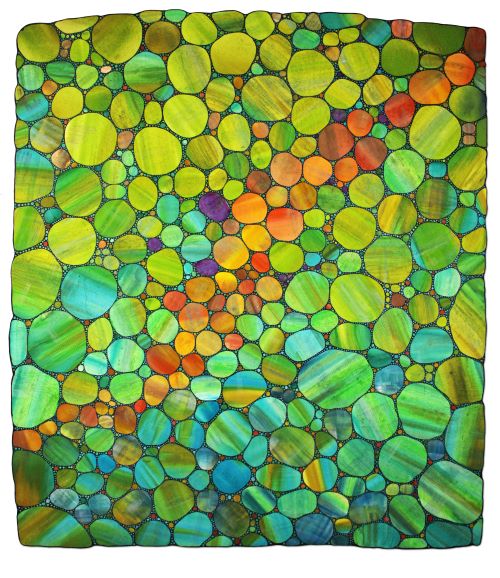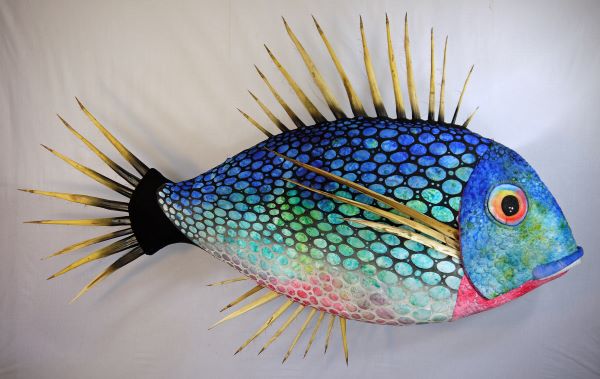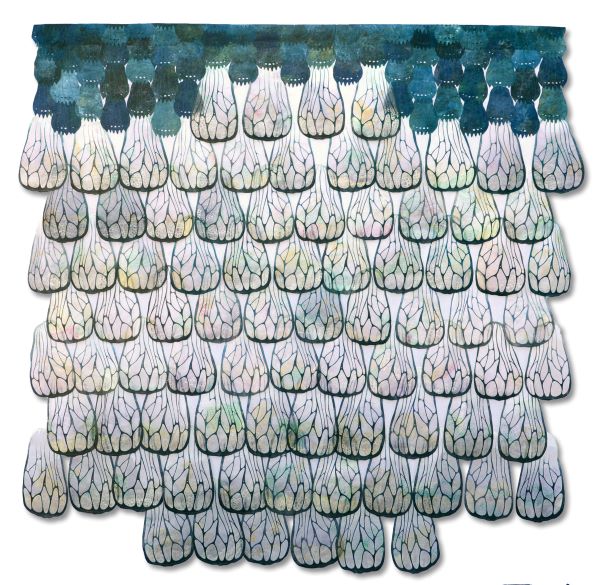SAQA Seminar - Unit 3
Artist Q&A Betty Busby - Selling Your Art
Tell us about your background.
I majored in ceramics at the Rhode Island School of Design and established a custom ceramic manufacturing plant the following year.
We were self-financed, so most of the manufacturing process needed to be constructed from the ground up. The existing machines to manufacture the product were far beyond our financial reach, and in addition, we were working in a temperature range that was quite a bit beyond what was being used at the time.
I had a large monthly payroll to cover, huge utility bills, a mortgage to pay, and governmental regulations to comply with, all of which began when I was 20 years old and continued for 18 years. Workflow was critical to staying in business: if the making of the product stopped for any reason and orders went unfilled, then everything would grind to a halt.
When I sold the business and moved to New Mexico, I signed a noncompete agreement with the buyers which stated that I could not make ceramics for seven years. That precipitated my switch to fiber, which had always been a love of mine since my first dumpster diving days of quilt making.
I believe that my background running a ceramics business influences the way I approach my fiber art to this day.
How do you sell your work regularly?
In my opinion, there is one basic thing an artist needs to be able to sell regularly: a desire and willingness to Do. The. W.O.R.K.
There seems to be a popular misconception that we can wait for inspiration to waft in the window, and then spend 6 to 12 months working on one thing, while taking time out for vacations, etc. If one is in that position financially, that's great, but it does not contribute to a dependable source of income.
Do you work with art agents?
I work with two art agents, one on the East Coast, one on the West. They collaborate with architects and interior designers on new construction, mostly in the healthcare fields. The commissions I have received from them have ranged from representational to abstract, but are all based on work of mine that is already done.
It's important to handle contracts and deadlines responsibly and promptly--there is no excuse for unprofessionalism, which will definitely negatively impact future sales as well.

Red River
What do you think about gallery representation?
Gallery representation is great and can be very educational as well. My New England gallery was instrumental in changing the direction of my work from doing only gigantic wall pieces to a more varied output in terms of size and subject matter.
However, we also need to keep in mind that galleries need to stay in business. It's important to maintain the same price structure and not to undercut them, but also you should keep in mind that the things that sell best for them may not be the direction that your work should be taking. You need to balance the possibility of sales against where your art needs to go.
Why is it important to enter exhibitions?
I believe it is important to enter shows for several reasons. The art world, in general, is becoming much more receptive to fiber, so it's worth considering all media shows in addition to the *quilt* exhibitions we think of first.
Most important is the visual feedback that you get when viewing your work in a gallery setting. You can join all the critique groups you want, but when you see your work in a show, the visual impact is very apparent--both positive and negative. And if we can't learn from our faults, then we'll never get better.
Secondly, there is the possibility of sales from exhibitions. In our most recent SAQA regional show in Santa Fe, New Mexico, I sold two of my four pieces and could have sold two more if they weren't already committed to going on tour.
Finally, you can increase the chance of being offered your own solo show if your work is seen by curators. I feel that having solo exhibitions is a more appropriate goal to focus on than attempting to get into large group shows with 35 to 80 other artists. Not that it's not a good idea to enter the large shows; it is, but there are much more rewarding things out there than getting into Quilt National. Being in control of your own exhibition, and having the ability to show a range of your work, will ultimately be much more fulfilling.

Spike the Yucca Fish
Would you tell us about a major success?
I was asked by the director of the Capitol Collection in Santa Fe, New Mexico, to curate an invitational fiber/mixed media exhibition in 2018. She gave me free rein to choose work in any size. As it is my home state, I was able to include installations of local artist work without the constraint of any shipping requirements.
The show was received so well that we are doing another in 2020, so I think of that as my biggest accomplishment to date.
How about a failure or challenge?
Failures? There have been many!
I had been using a stiffening product on some of my sculptures that has turned out to be susceptible to excessive heat. During shipping, sections of the work can become misshapen, so I'm having to go back and repair them on an individual basis. Of course, I'm no longer using that product and will add heat resistance to my continual testing of new materials.

Wing
How do you determine pricing?
I don't actually have that many price points for my work. In my mind, things are big, small, or medium, and are priced accordingly. I would much rather have something I made be out in the world than gathering dust under my bed!
My three-dimensional work has sold well, however, due to the cost of shipping, as well as the increased difficulty of making it, there are fewer pieces in that category.
I don't do open studios or art fairs, mostly because lower price point items ($100 or less) are necessary for success in doing those and I just don't make that type of work.
Any other pieces of advice?
Advice for selling your work? Just do it! Nothing can replace the time and energy you put into your work. All the other stuff, like getting into shows, worrying what Joe Blow down the street is doing, and even sales are beside the point.
It all comes from inside: don't be afraid to try and fail. It's the only way to learn.

